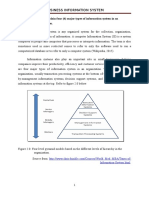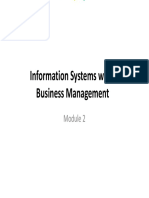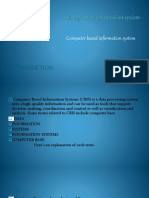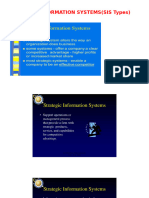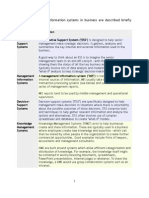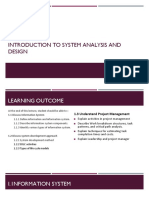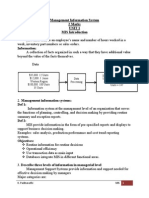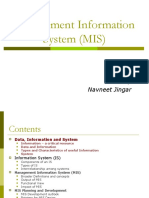Management Information Systems
Management Information Systems
Uploaded by
DivyaDeepthi18Copyright:
Available Formats
Management Information Systems
Management Information Systems
Uploaded by
DivyaDeepthi18Copyright
Available Formats
Share this document
Did you find this document useful?
Is this content inappropriate?
Copyright:
Available Formats
Management Information Systems
Management Information Systems
Uploaded by
DivyaDeepthi18Copyright:
Available Formats
Management Information Systems (MIS):
Definition And Explanation:
A management Information system Basic (MIS) is an information system that provides predefined types of information Computer to management. Historically, the main Science output of management Information The Age of system (MIS) was hard copy summary Information and exception reports that were distributed by the management Types of Computer and Information system (MIS) department to Digital Age line department at periodic intervals or on demand. Today, reports are still the Input and Output Devices mainstay of the management Information system (MIS). With the infusion of Storage Devices Of display technologies into today's business Computer workplace, however many of the Central information outputs traditionally available Processing in hardcopy from with an management Unit Information system (MIS) are now Software: The available in screen form. Also, the range Power Behind The Power of reports type is much greater. For Data example, the continuously scrolled Communicatio displays at airports showing arrivals and n and departures of planes (or those at stock Computer market showing changes in stock price) Networks provide predefined and structured types of The Nature Of information. The form of this information; Information however could not traditionally be considered a report. The System Management information systems (MIS) serve the lower and middle management level of the organization, providing managers with reports and, in some cases, with on-line access to the organization's current performance and historical records. Typically, they are oriented almost exclusively to internal, not environmental or external, events. Management information system (MIS) primarily serve the functions of planning, controlling, and decision making at the management level. Generally, they are dependent on underlying transaction
Theory Organizational Information System (IS): Transaction Processing System (TPS) and Management Information System (MIS) Organizational Information system (IS): Decision Support
processing systems for their data. Management Information system (MIS) summarize and report on the basic operations of the company. The basic transaction data from TPS are compressed and are usually presented in long reports that are produced on a regular schedule. Management Information system (MIS) usually serve managers interested in weekly, monthly, and yearly results not day-to-day activities. Management Information system (MIS) generally address structured questions that are known well in advance. These systems are generally not flexible and have little analytical capability. Most management information system (MIS) use simple routines such as summaries and comparisons, as opposed to sophisticated mathematical models or statistical techniques. Management Information system (MIS) is used for both management planning and management control functions. Because management Information system (MIS) reports are associated with managerial decision-making, their value is often hard to quantify. Information system at middle and lower level of an organization that serve the functions of planning, controlling, and decision making by providing routine summary and exception reports. Management Information system (MIS) generates the preplanned printed reports for decision-making purposes. Reports produced through an management Information system (MIS) are commonly by-product extensive and detailed databases assembled by Transaction Processing System.
System (DSS) and Executive Support System (ESS) Organizational Information System (IS): Expert System (ES) and Office Information System (OIS)
Basics of Computer Science Questions and Answers
Basics of Information Technology Questions and Answers Computer Architecture Questions and Answers Data Communicatio n Questions and Answers Information Networks Questions and Answers Fundamentals of the Internet Questions and Answers Application and Uses of Computer Questions and Answers Security, Copyright and The Law Questions and Answers
Properties of Management Information System:
Support structured and semi structured decisions, primarily at
the middle and lower level management Management Information system (MIS) is intended principally to assist middle level management. It helps them with tactical decisions. It enables them to spot trends and get an overview of current business activities. Provide fixed types of reports in an established format Management Information system (MIS) are relatively inflexible The information requirements of users are normally known and stable Often hardcopy reports Usually require a formal run schedule Management Information system (MIS) generally aid in decision making using past and present data Management information system (MIS) rely on existing corporate data and data flows Usually consists of internal operational data rather then data about the external environment More concerned with data about the past than data relating to the future Often oriented to summary and exception reporting
Windows Operating Systems Questions and Answers Spreadsheet Software Questions and Answers Process Management in CPU Questions and Answers CPU Scheduling Questions and Answers Process Synchronizatio n Questions and Answers Deadlocks Questions and Answers Memory Management Question and Answers
Operating Systems
Introduction to Operating System Introduction to Process Management Threads and CPU Scheduling Process Synchronizatio n in Operating System
Documents & Reports by Management Information System:
An MIS can produce either hardcopy report output or soft outputs. As mentioned earlier, hardcopy reports are the most common form of output produced by an MIS.
Reports produced by management Information system (MIS) usually fall into one of four categories: scheduled reports, exception reports, demand reports, summary reports.
Deadlocks Memory Management in Operating System Virtual Memory in Operating System File System Management in Operating System I/O and Device Management Security Linux Operating System
a. Scheduled Reports:
Scheduled reports also called periodic reports are those that are issued periodically i.e. hourly, daily, weekly, monthly, quarterly, or annually. Examples of such reports are daily production report and monthly performance report. These types of reports can be used either for planning or control purposes.
b. Exception Reports:
Exception reports are issued when something unusual takes place that require the attention of management. For instance, an expense overrun would likely trigger the generation of an exception report or an inventory report that lists only those items that number fewer than 10 in stock. Exception reports are used primarily for control purposes.
c. Demand Reports:
Demand reports are generated when Database someone with authority request Management information in response to an unscheduled System demand. An executive asking for a financial report or director finance order a Introduction to credit background report of an unknown Database Systems customer who want to place a large order.
d. Summary Reports:
Summary reports show totals and trends. An example would be a report showing total sales by office, by product, by salesperson, of overall total sales.
Database System Architecture Database Administration and Database Development Process The EntityRelationship Model
Relevant Articles:
What is Information System
Information System Development Process Information System in an Organization of Transaction Processing Function(TPS) System Documents and Reports Generation Transaction Processing Sub system Management Information System (MIS) Examples of Management Information at the Tactical Level
Semantic Object Model Logical Database Design and Relational Data Model Normalization in Database Transformation of E-R Model into Relational Data Model Representing Semantic Object Model and Types of Semantic Object Model Physical Database Design Introduction to Structured Query Language (SQL) Implementation of Relational Database and Database Application Design Client Server Database Systems & Open Database Connectivity (ODBC)
Home
Contact us
About us
Privacy policy Advertise
Link to us
Resources
Copyrights of all content on this web site are owned by Basicsofcomputer except where indicated in source or copyright statements. basicsofcomputer must be contacted for permission to copy or redistribute any material published on this website. Copyright 2011 Basicsofcomputer. All rights reserved. Online Micro, Macro and Developmen
You might also like
- Management Information systems - MIS: Business strategy books, #4From EverandManagement Information systems - MIS: Business strategy books, #4No ratings yet
- Measuring Itsm: Measuring, Reporting, and Modeling the It Service Management Metrics That Matter Most to It Senior ExecutivesFrom EverandMeasuring Itsm: Measuring, Reporting, and Modeling the It Service Management Metrics That Matter Most to It Senior ExecutivesNo ratings yet
- JAMES A. HALL - Accounting Information System Chapter 1Document41 pagesJAMES A. HALL - Accounting Information System Chapter 1Joe VaTa75% (4)
- Report On WiresharkDocument9 pagesReport On Wiresharkphenixjpr100% (2)
- 01 - Introduction To Information SystemsDocument58 pages01 - Introduction To Information SystemsTrina Mae OcampoNo ratings yet
- Tps Mis Dss Eis Notes 2000 2001s2Document53 pagesTps Mis Dss Eis Notes 2000 2001s2sagar19018No ratings yet
- 3440 System Analysis and Design NotesDocument105 pages3440 System Analysis and Design NotesEdwin OdhiamboNo ratings yet
- Problems in Business Are Undesirable: Basic IdeasDocument32 pagesProblems in Business Are Undesirable: Basic IdeasMayank SharmaNo ratings yet
- Class: BBA 5 Credit HoursDocument28 pagesClass: BBA 5 Credit HoursMuiz SaddozaiNo ratings yet
- Sad Comprehensive Notes 114958Document131 pagesSad Comprehensive Notes 114958eolumwaNo ratings yet
- Bis Module 1 AssignmentDocument7 pagesBis Module 1 AssignmentSaras VathyNo ratings yet
- Module - 2 - MIS - CSIT204Document47 pagesModule - 2 - MIS - CSIT204aakash sharmaNo ratings yet
- Management Information System-Challenges of Information System - Lesson2Document22 pagesManagement Information System-Challenges of Information System - Lesson2Natasha GoenkaNo ratings yet
- Q.No.1 Write Down Various Problems Associated With Traditional OfficeDocument8 pagesQ.No.1 Write Down Various Problems Associated With Traditional OfficePrerna KhatriNo ratings yet
- 4 CbisDocument29 pages4 CbisSheikh ObaidNo ratings yet
- Structures of Information System in Origination and TypesDocument19 pagesStructures of Information System in Origination and TypesDegu DegaregNo ratings yet
- Computer Based Information SystemDocument44 pagesComputer Based Information SystemAnam MalikNo ratings yet
- Types of Information Systems in An OrganizationDocument8 pagesTypes of Information Systems in An Organizationimmanjeri39No ratings yet
- MisDocument4 pagesMisVijay BharathNo ratings yet
- Chapter_2Document46 pagesChapter_2backhaileupNo ratings yet
- Introduction To Common Used System and ModelsDocument12 pagesIntroduction To Common Used System and ModelsBiplab BiswasNo ratings yet
- Diferrent SI Level Organization 40275Document18 pagesDiferrent SI Level Organization 40275Ariel AdhidevaraNo ratings yet
- The Main Kinds of Information Systems in Business Are Described Briefly BelowDocument11 pagesThe Main Kinds of Information Systems in Business Are Described Briefly BelowDrPallati SujendraNo ratings yet
- Amity Business School: MBA, Semester - 3 Management of Software Projects Teena BaggaDocument55 pagesAmity Business School: MBA, Semester - 3 Management of Software Projects Teena BaggaAvi KoolNo ratings yet
- HAT ARE THE Most Common Types OF Information System IN AN OrganizationDocument5 pagesHAT ARE THE Most Common Types OF Information System IN AN OrganizationMayank SharmaNo ratings yet
- Competency Level 17Document6 pagesCompetency Level 17Ruhshath RafiNo ratings yet
- CBISDocument6 pagesCBISNida HassanNo ratings yet
- Management Information System (MIS)Document54 pagesManagement Information System (MIS)ssayem5142No ratings yet
- System Analysis and DesignDocument35 pagesSystem Analysis and DesignRahul HumpalNo ratings yet
- Bab 1Document57 pagesBab 1SYED AHMAD SHAUQI BIN SYED SHUHAIMINo ratings yet
- Management Information SystemDocument56 pagesManagement Information SystemSunil SharmaNo ratings yet
- Different Application of Information Systems: Packet Voip Broadband DSL IP AddressDocument5 pagesDifferent Application of Information Systems: Packet Voip Broadband DSL IP AddressAseel AseelNo ratings yet
- Transaction Processing SystemDocument3 pagesTransaction Processing SystemParteek SidhuNo ratings yet
- VND Openxmlformats-Officedocument Presentationml Presentation&rendition 1Document26 pagesVND Openxmlformats-Officedocument Presentationml Presentation&rendition 1jaykapdikapdiNo ratings yet
- It Concepts and Management: ISD 458: E-Logistics & Supply Chain Management Unit TwoDocument16 pagesIt Concepts and Management: ISD 458: E-Logistics & Supply Chain Management Unit TwoNtuda DanielNo ratings yet
- Unit IDocument29 pagesUnit Imanishchavhan02No ratings yet
- Information System: Operational-Level Systems Support Operational Managers by Keeping TrackDocument17 pagesInformation System: Operational-Level Systems Support Operational Managers by Keeping TrackAvreile RabenaNo ratings yet
- Organizations and Information Technology SupportDocument28 pagesOrganizations and Information Technology SupportKumpulan DzbNo ratings yet
- Chapter # 1: Foundations of Information Systems in BusinessDocument25 pagesChapter # 1: Foundations of Information Systems in Businessdua tanveerNo ratings yet
- Assignment Activity Module For MIS Chapter 2Document16 pagesAssignment Activity Module For MIS Chapter 2Yanna MendozaNo ratings yet
- Management Information SystemDocument98 pagesManagement Information SystemPranjit BhuyanNo ratings yet
- CBIS (Computer Based Information System) : DataDocument7 pagesCBIS (Computer Based Information System) : Dataخالد ناهض نايف نجمNo ratings yet
- Managment Info Sys LecturesDocument55 pagesManagment Info Sys Lectureskhan ArkamNo ratings yet
- Mis & ErpDocument11 pagesMis & Erpkar3kNo ratings yet
- MIS BBA 6th Sem UNIT 1-2-3Document167 pagesMIS BBA 6th Sem UNIT 1-2-3thakurrohit22614No ratings yet
- Management Information System: Conceptual FoundationsDocument66 pagesManagement Information System: Conceptual Foundationsrishav2626No ratings yet
- Management Information SystemDocument61 pagesManagement Information Systempammy31350% (2)
- Chapter 2 - GLOBAL E-BUSINESSDocument49 pagesChapter 2 - GLOBAL E-BUSINESSToukyer AhmedNo ratings yet
- MIS ClassificationDocument25 pagesMIS Classificationanahad VaidyaNo ratings yet
- Chapter 2: Information Systems in The EnterpriseDocument37 pagesChapter 2: Information Systems in The Enterpriseak9922No ratings yet
- Introduction To System Analysis and DesignDocument22 pagesIntroduction To System Analysis and DesignHiranya100% (2)
- Unit 1 - Lecture 1Document15 pagesUnit 1 - Lecture 1IMRAN ALAMNo ratings yet
- MBA Anna University-Management Information System 2 MarksDocument24 pagesMBA Anna University-Management Information System 2 Markspadma_abivarshini92% (12)
- Sad Comprehensive NotesDocument132 pagesSad Comprehensive Notesmichaelodhiambo692No ratings yet
- Information Technologies: Concepts and ManagementDocument41 pagesInformation Technologies: Concepts and ManagementParth PatadiaNo ratings yet
- Operations Support SystemDocument9 pagesOperations Support SystemAnmol GuptaNo ratings yet
- MIS Module 2-1Document61 pagesMIS Module 2-1Yadhu KrishnaNo ratings yet
- Management Information Syste1Document9 pagesManagement Information Syste1DerickMwansaNo ratings yet
- Management Information System (MIS) : Navneet JingarDocument54 pagesManagement Information System (MIS) : Navneet JingarHimanshu GargNo ratings yet
- Zero To Mastery In Cybersecurity- Become Zero To Hero In Cybersecurity, This Cybersecurity Book Covers A-Z Cybersecurity Concepts, 2022 Latest EditionFrom EverandZero To Mastery In Cybersecurity- Become Zero To Hero In Cybersecurity, This Cybersecurity Book Covers A-Z Cybersecurity Concepts, 2022 Latest EditionNo ratings yet
- 1 RMNCHA StrategyDocument83 pages1 RMNCHA StrategyDivyaDeepthi18No ratings yet
- Institute of Mental Health (Erragadda) : HistoryDocument2 pagesInstitute of Mental Health (Erragadda) : HistoryDivyaDeepthi18No ratings yet
- Cadabams Rehabilitation CenterDocument6 pagesCadabams Rehabilitation CenterDivyaDeepthi180% (1)
- Scientific Programme (Tentative)Document2 pagesScientific Programme (Tentative)DivyaDeepthi18No ratings yet
- A) Teacher Awards at University LevelDocument6 pagesA) Teacher Awards at University LevelDivyaDeepthi18No ratings yet
- Poster Presentation Guidelines: Theme: "Innovations and Updates in Hospitals" Last Date For Registration: 30Document1 pagePoster Presentation Guidelines: Theme: "Innovations and Updates in Hospitals" Last Date For Registration: 30DivyaDeepthi18No ratings yet
- Free Awareness Material For WebsiteDocument1 pageFree Awareness Material For WebsiteDivyaDeepthi18No ratings yet
- Ethics in Nursing ResearchDocument22 pagesEthics in Nursing ResearchDivyaDeepthi18100% (1)
- Question Bank RMDocument14 pagesQuestion Bank RMDivyaDeepthi18No ratings yet
- Schedule Notification For B.SC (N) - 2Document3 pagesSchedule Notification For B.SC (N) - 2DivyaDeepthi18No ratings yet
- Research Methods in Business: Overview of SyllabusDocument12 pagesResearch Methods in Business: Overview of SyllabusDivyaDeepthi18No ratings yet
- RM - One WordDocument155 pagesRM - One WordDivyaDeepthi18No ratings yet
- Sample Designs and Sampling ProceduresDocument9 pagesSample Designs and Sampling ProceduresDivyaDeepthi18No ratings yet
- Sl. No Name of The Medal / Prize Eligibility Criteria Name of The Donor Name of The Candidate Who Received The Medal in 2013Document5 pagesSl. No Name of The Medal / Prize Eligibility Criteria Name of The Donor Name of The Candidate Who Received The Medal in 2013DivyaDeepthi18No ratings yet
- Woos Ley DissDocument122 pagesWoos Ley DissDivyaDeepthi18No ratings yet
- Resume Book 2012Document40 pagesResume Book 2012DivyaDeepthi18No ratings yet
- Viva-Voce Examination: Reference Name of The Candidate Title of The Thesis Viva Date SubjectDocument13 pagesViva-Voce Examination: Reference Name of The Candidate Title of The Thesis Viva Date SubjectDivyaDeepthi18No ratings yet
- Counseling Psychology vs. Clinical PsychologyDocument3 pagesCounseling Psychology vs. Clinical PsychologyDivyaDeepthi18No ratings yet
- Human Resource Indicators and Health Service PerformanceDocument20 pagesHuman Resource Indicators and Health Service PerformanceDivyaDeepthi18No ratings yet
- Competency Gaps in Human Resource Management in The Health SectorDocument4 pagesCompetency Gaps in Human Resource Management in The Health SectorDivyaDeepthi18No ratings yet
- Employment BrandingDocument18 pagesEmployment BrandingDivyaDeepthi18No ratings yet
- Practitioner: Positive Change in Health CareDocument2 pagesPractitioner: Positive Change in Health CareDivyaDeepthi18No ratings yet
- India PR WireDocument2 pagesIndia PR WireDivyaDeepthi18No ratings yet
- CarlosVillar MSC ThesisDocument120 pagesCarlosVillar MSC ThesisDivyaDeepthi18No ratings yet
- DH-NVR608/608R-64-4KS2: 64 Channel Super 4K H.265 Network Video RecorderDocument3 pagesDH-NVR608/608R-64-4KS2: 64 Channel Super 4K H.265 Network Video RecorderLuis De la RosaNo ratings yet
- ECE 375: Computer Organization and Assembly Language ProgrammingDocument5 pagesECE 375: Computer Organization and Assembly Language ProgrammingTiktok IndiaNo ratings yet
- 02-HUAWEI UC Technologies and Standards Sales Specialist Training V1.0Document39 pages02-HUAWEI UC Technologies and Standards Sales Specialist Training V1.0amar kingNo ratings yet
- EX: 1 Basic of Unix Commands: Write The Basics of UNIX Commands For File Processing and Working With DirectoriesDocument9 pagesEX: 1 Basic of Unix Commands: Write The Basics of UNIX Commands For File Processing and Working With DirectoriesSherril VincentNo ratings yet
- Answer: A, DDocument68 pagesAnswer: A, Dsohail peerjadeNo ratings yet
- 3GPP TS 32.435 PM MeasurementsDocument16 pages3GPP TS 32.435 PM MeasurementsAbhishek BudhawaniNo ratings yet
- How To Get Temperature On A Point (Created With Surface - Point') in A UDFDocument3 pagesHow To Get Temperature On A Point (Created With Surface - Point') in A UDFAhmed HazemNo ratings yet
- Ahmed TaherDocument5 pagesAhmed TaherAshraf Sayed AbdouNo ratings yet
- Data Sheet - DCS Master P-5000 IO Test System PDFDocument12 pagesData Sheet - DCS Master P-5000 IO Test System PDFtriplbingaziNo ratings yet
- Open Source and Free Business Intelligence SolutionsDocument39 pagesOpen Source and Free Business Intelligence SolutionsAdabala Nageswara RaoNo ratings yet
- Assignment 2 - Data Structure ComparisonDocument5 pagesAssignment 2 - Data Structure ComparisonAnonymous aiVnyoJbNo ratings yet
- Dcap407 Data StructureDocument270 pagesDcap407 Data StructureJagat Mishra100% (1)
- S.No: 1 Exp. Name: DateDocument3 pagesS.No: 1 Exp. Name: DateSai KiranNo ratings yet
- Cyber Hunter InstallerDocument12 pagesCyber Hunter InstallerDaniel DantesNo ratings yet
- COMP231: ER DiagramDocument52 pagesCOMP231: ER DiagrambutooooNo ratings yet
- Chapter 7 PDFDocument3 pagesChapter 7 PDFIrfan AhmedNo ratings yet
- Linear Data Structure FinalDocument47 pagesLinear Data Structure FinalMahomuda AkterNo ratings yet
- Gerber FilesDocument200 pagesGerber FilesguttiNo ratings yet
- Maintaining Computers (Physically & LogicallyDocument12 pagesMaintaining Computers (Physically & LogicallyDenielle MarceñoNo ratings yet
- Digital CommunicationMCQDocument3 pagesDigital CommunicationMCQZahid Yousuf0% (1)
- Date Summary of ChangesDocument5 pagesDate Summary of ChangesCHENFU LlUNo ratings yet
- Oracle HistoryDocument14 pagesOracle Historyanon-36924No ratings yet
- It 12 Integrative Programming and Technologies Learnerx27s Module Unit Final PeriodDocument59 pagesIt 12 Integrative Programming and Technologies Learnerx27s Module Unit Final PeriodIftikharNo ratings yet
- Practical Exercises: Genexus Core CourseDocument36 pagesPractical Exercises: Genexus Core Coursefalmeida7hotmail.comNo ratings yet
- D B M S: ATA ASE Anage Me NT YstemDocument114 pagesD B M S: ATA ASE Anage Me NT YstemAkash SachanNo ratings yet
- DS2502 1Kb Add-Only Memory: Features Pin AssignmentDocument24 pagesDS2502 1Kb Add-Only Memory: Features Pin AssignmentrogeriocorreaNo ratings yet
- Cruise Travel ManagementDocument19 pagesCruise Travel Managementmayurcj18No ratings yet
- Computer Science Model PaperDocument4 pagesComputer Science Model Paperpriyanshu gorghateNo ratings yet
- MODULE CHS 5 Perform Mensuration and CalculationDocument5 pagesMODULE CHS 5 Perform Mensuration and CalculationJoel Cabusao LacayNo ratings yet











